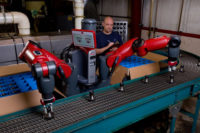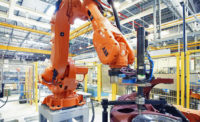Robots Save Jobs, They Don't Lose Them

Back in February, Terry Gou, founder and chairman of contract manufacturer Foxconn Technology Group, said he hopes to automate 70 percent of the company’s assembly operations within three years. The company, which assembles approximately 40 percent of all the consumer electronic products sold worldwide, sees robotics as a major investment direction for 2015. “I believe that in the future, the robotics industry will be bigger than the auto industry,” says Gou.
Bold words from a bold businessman? Or mere braggadocio? Although Foxconn has factories all over the world, China is by far its manufacturing hub. The company operates 12 assembly plants in nine Chinese cities—more than in any other country—and two more Chinese factories are in the works. Why would a company with that kind of manufacturing presence in China, a so-called cheap labor center, want to go all-in on robotics?
A study published in March by the London School of Economics and Political Science provides an answer. Researchers George Graetz and Guy Michaels found that industrial robots have been a substantial driver of labor productivity and economic growth worldwide.
The researchers looked at new data from the International Federation of Robotics to analyze the use of robots across 14 industries in 17 countries between 1993 and 2007. Overall, they conclude that the use of robots within manufacturing raised the annual growth of labor productivity and gross domestic product (GDP) by 0.36 and 0.37 percentage points, respectively. That might not seem like a lot, but it represents 10 percent of total GDP growth and 16 percent of labor productivity growth. What’s even more astounding is that, during the study’s time period, robots produced such an impact while accounting for just 2.25 percent of the total assets of the industries studied.
The researchers go on to suggest that robots are now a true “general purpose technology”—like the steam engine or information and communications technology (ICT)—that is having a pervasive, long-standing impact on a number of dissimilar industries.
Indeed, the researchers note that the steam engine increased labor productivity by 0.35 percentage points annually between 1850 and 1910, or about the same as robots did during their study period. Similarly, ICT increased labor productivity by approximately 0.6 percentage points annually percent between 1995 and 2005—or about twice the rate for robotics during the study period. However, capital investment in IT from 1995 to 2005 was also five times higher than spending on robots from 1993 to 2007.
While there will always be Luddites who despair that robots took their jobs, Graetz and Michaels provide a convincing argument that quite the opposite is true. Whether you live in China or the United States, robots create and save manufacturing jobs, they don’t lose them.
Looking for a reprint of this article?
From high-res PDFs to custom plaques, order your copy today!






